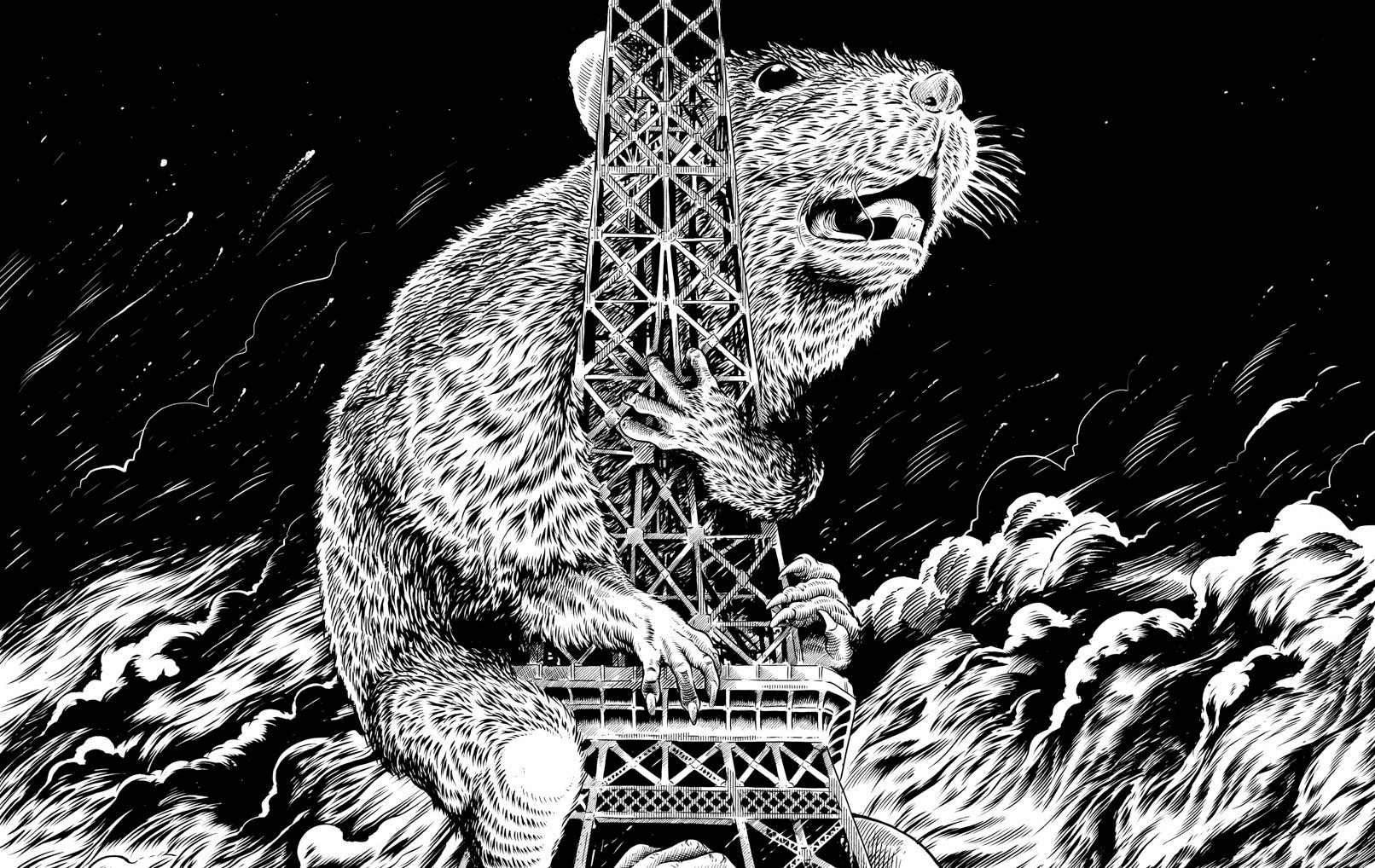
The three ratropolises: Paris, New York and London, are more full of rats than ever
In the 2007 animated film Ratatouille, the rodent protagonist, Remy, is taken by his father to see the shop window of a Parisian rat catcher for a lesson in the laws of the universe. Alongside shelves packed with lethal rodenticides, dead rats swing by their necks from a makeshift gibbet. This, the young Remy is warned, is what happens when rats dare get too close to humans. Their world is one that belongs to an enemy.
The inspiration for the shop portrayed in the film is Maison Aurouze, said to be the oldest rat catcher’s in Paris. Founded in 1872 and still going today, the shop’s polished glass frontage displays assorted taxidermy rats that have been collected in various states of misfortune. Any passing rat would be wise to heed warning, for ours is an ancient enmity. And nowhere are the battle lines more pronounced than in Paris, which, alongside New York and London, is one of the great ratropolises of the Western world.
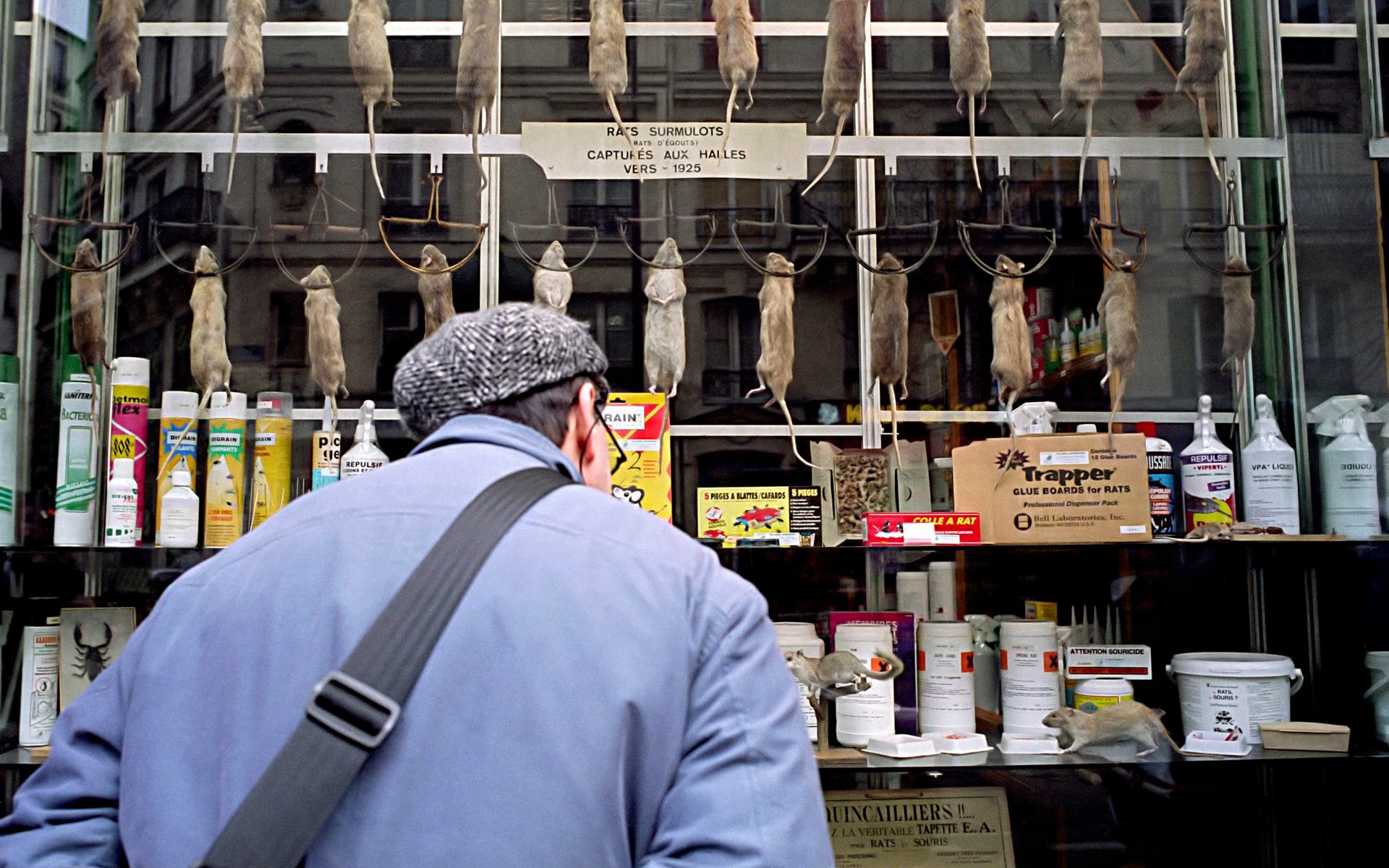
Maison Aurouze is reportedly the oldest rat catcher in Paris – Alamy Stock Photo
The French even have a word for it: dératisation, which translates loosely as ‘the ridding of rats’. Throughout much of the past 100 or so years, Parisians have been engaged in a process of all-out war on their rodent residents. In the summer of 1920, after rat populations that had boomed along the trench networks of the Western Front streamed into the city alongside returning soldiers, the city pledged to eradicate a ‘grey invasion’ that was, in the words of one contemporary journalist, ‘as difficult to conquer as the Germans’.
Citizens formed vigilante groups, patrolling the streets with dogs, clubs and guns. Approximately 500,000 rats were killed over the course of a year, but to little overall effect. Indeed a century on, Paris is still teeming with rodents. You can spot them scurrying over the manicured gravel of the Tuileries and along the banks of the Seine. A one-star review of the Eiffel Tower on Tripadvisor is headlined simply: ‘Rats.’ So numerous have they seemingly become, in fact, that in the well-heeled 17th arrondissement, modern-day citizen brigades have once more clubbed together to rid their streets of rats.

An etching of a rat catcher in Paris, mid to late 17th century – Sepia Times
And yet a truce is in the offing, one that could have implications for us all. The Parisian authorities are considering a novel approach to rodent control which is increasingly being recognised in a host of other urban conurbations. The war on rats has long turned into a fruitless stalemate. Perhaps it is time to hoist the white flag and usher in a new era of benevolent co-existence?
In June 2023, the Paris deputy mayor for public health announced that a committee was being established to consider the prospect of ‘cohabitation’ with the city’s rats. This marked a significant departure from previous policies of dératisation. The decision could herald a new dawn in Paris’s relationship with its rats, one that has not been universally well received. While some pro-rat campaigners have taken to the streets wielding banners that declare ‘rats are not our enemies’, during strikes over pension reform last year rat catchers threw the bodies of dead rodents at the Paris city hall to, in the words of one union organiser, ‘show the hard reality of their mission’.

Pro-rat campaigners take to the streets of Paris, March 2023 – AFP
Alongside these official entreaties, a collective of scientists based around the National Museum of Natural History in Paris have launched a project intended to finally unpick the secret lives of the city’s famous inhabitants. They cite three main objectives: to decode the biology and ecology of rats in Paris and use genetic testing to map the dynamics of populations; to better understand the diseases they carry and the risks of transmission to humans; and to help explain people’s own prejudices towards rats. The name given to the study is fitting for an animal so regularly blamed for hastening humanity’s demise: Project Armageddon.
Essentially the concept of cohabitation boils down to live and let live, much as we do with urban foxes or squirrels. Professor Christiane Denys, a palaeontologist and rodent expert involved in Project Armageddon, tells me that she hopes the work will break down myths around rats and explain to people how we might better coexist. She is dismissive of current attempts to limit or even wipe out rat populations with poison, pointing out that, worldwide, scientists have already discovered more than a dozen genetic mutations in rats demonstrating resistance to anticoagulants (the poisons most commonly applied in an attempt to kill them). ‘Rats belong to an ecosystem and if you touch one part of an ecosystem you can destroy another,’ she warns.
Rats represent the worst of us, or at least that is what we tell ourselves. They are rapacious, over-sexed, destructive and pestilent. The term ‘rat’ is an insult; a verb as well as a noun. The dishonest rat each other out. When cornered, the morally culpable turn upon each other like rats in a sack. The Victorian author and chronicler of rats James Rodwell invites his reader to slowly pronounce the word aloud: R-A-T, savouring the disgust in every letter.

We have long regarded rats as invading pests – Hulton Archive
During the witch trials of the 16th and 17th centuries, rats were regarded as familiars of the devil. Modern cultural references are hardly more favourable. The vicious rat in Disney’s Lady and the Tramp is a greasy, sharp-fanged monster with yellow eyes and a swishing, addery tail who sneaks into the baby’s room. Beatrix Potter, who had her own pet fancy rat called Sammy, cast them in a less than favourable light in The Tale of Samuel Whiskers. Alongside his wife, Anna Maria, Samuel attempts to kidnap and eat a kitten in a roly-poly pudding.
Even the great Sir David Attenborough has acknowledged his own fear. ‘I really, really hate rats,’ he has said. ‘I don’t mean that I mildly dislike them as I dislike, let us say, maggots. I mean that if a rat appears in a room, I have to work hard to prevent myself from jumping on the nearest table.’
We have long been obsessed as a society with the notion of rats invading. In 1813, the Yorkshire-born journalist Charles Fothergill attempted some brief arithmetic on rat reproduction. He calculated that, left to their own devices, a single pair of rats would produce three million young during their three-year lifespan. Fothergill concluded that ‘the whole surface of the earth in a very few years would be rendered a barren and hideous waste, covered with myriads of famished grey rats, against which man himself would contend in vain’.
This is the sort of dodgy mathematics that has led to the old adage that ‘you are never more than six feet away from a rat’, or that there is a rat for every person in Britain. In short, nobody knows the true number. Much of what is floating around the internet is peddled by the pest-control industry itself, which clearly has a vested interest in an over-inflated public perception of the threat. Estimates of Britain’s rat population range from 10.5 million, to in excess of 200 million.
In 1947, during the post-war baby boom when overpopulation was becoming a source of wider concern, the US research psychologist John B Calhoun started conducting crowding experiments with rats. Calhoun’s neighbour agreed to let him build a quarter-acre enclosure in disused woodland behind his Maryland home, a pen he nicknamed ‘rat city’.

Paris joins New York City and London as one of the great ‘ratropolises’ of the world – AFP
The habitat, Calhoun imagined, was sufficient to accommodate 5,000 rats, and to kick things off he introduced five pregnant females. Brown rats can produce litters of up to 14 pups, and average around half a dozen. Given their ability to fall pregnant almost immediately after giving birth and gestate while simultaneously lactating, he presumed the woodland floor would soon be teeming. However, despite the provision of a constant supply of food over two years of research, the population never exceeded 200 and ultimately levelled off at around 150.
A few years later, while employed at the National Institute of Mental Health, Calhoun repeated the experiment but this time in indoor pens. Once more he introduced rats and provided food, water and bedding. Calhoun called this experimental world a ‘rat utopia’. But there was one limit deliberately imposed on this world that was different to his outdoor experiment: space.
The rodents bred prodigiously and the pens soon heaved with animals. Then something strange occurred: the rat society started to collapse in upon itself. Dominant males formed aggressive packs that attacked females and the young. Some rats became hypersexual, attempting to mate with everyone they encountered. Mothers abandoned and even attacked their pups as infant mortality rose to 96 per cent. Cannibalism was rife. What became left of rat utopia was a group of terrified subordinate rodents huddled together for safety in the middle of the pen while the more feral inhabitants of the colony roamed the perimeter. The population crashed and did not recover.
Published in 1962, Calhoun’s study came at a time of rapid urban expansion. Calhoun termed his findings of the rats’ descent into vice and destruction a ‘behavioural sink’. This was a horror story that resonated deeply.
There are two species of rat in the UK: the brown rat (Rattus norvegicus) and black rat (Rattus rattus). While there is evidence of black rats present in Roman Britain, they are now restricted to just a few population clusters, having been gradually displaced by the larger brown rat. Both are invasive species (brown rats originated in China, and black rats in the Indian subcontinent) and have followed humans wherever they have gone. Now found on every continent except Antarctica, rats are one of the most populous and successful mammals on earth. Nearly the most destructive, too – although that particular mantle belongs to us. It would be disingenuous to suggest that rats are not a pest and, in the right circumstances, a threat. It would, in fact, be difficult to envisage a more effective harbinger of pestilence than the rat: muscular, ferocious, with incisors that are stronger than steel and bodies capable of squeezing through the tiniest of gaps to access food sources in our homes.
Rats, along with other rodents, pilfer one-fifth of the world’s food harvest and can devastate populations of animals and seabirds. They are also a reservoir of pathogens known to cause more than 70 diseases. Rats have been found to harbour bubonic plague, cholera, typhus, leptospirosis, cowpox and hantavirus infection. A 2014 study from Columbia University found that the average New York City subway rat carried 18 novel viruses not yet detected in humans, along with dozens of familiar pathogens.

Rats have become a cause of concern for hygiene on the New York City subway – Corbis News
However, researchers have recently attempted to exonerate rats as single-handedly spreading plague. One 2018 study of Black Death mortality data conducted by researchers in Norway and Italy claimed human-borne fleas and lice were more likely responsible for causing the 14th-century epidemic, which killed up to half the population of Europe. Meanwhile, another study, published in the prestigious journal Proceedings of the National Academy of Sciences in 2015, argued that the Black Death could have originated from gerbils in Asia, rather than rats.
That connotation with the plague, as well as a desire to maximise food production at all costs, drove the rat wars of the 20th century. In 1908, the first ever ‘rat destruction bill’ was introduced to the House of Commons. A decade later, following intensive lobbying by a group of wealthy landowners known as the Vermin Repression Society, the British government passed the Rats and Mice (Destruction) Act 1919, placing a legal obligation on every private individual to destroy rodents and deal with any infestation on land or property they owned, or face a £5 fine. According to the chairman of the Vermin Repression Society, Alfred E Moore, it was ‘the sacred duty of every living one of us to take his or her place in the world war against these living emblems of depredation, filth and disease’.
Moore encouraged various methods of extermination: fumigating hedgerows with high-strength sulphur dioxide gas, flooding rat burrows with tar and beating any escapees to death with sticks. The Boy Scouts and Women’s Land Army were later deployed to dispatch any rat they could find across the nation’s farms, including pumping Cymag (a now-banned cyanide gas) into burrows. The slogan the authorities adopted was: ‘Kill that rat! It’s doing Hitler’s work.’
But the rats had the advantage of any guerrilla army: an ability to launch nocturnal raids and retreat into secret burrows, a shared intelligence network and a hugely effective spying operation, combined with an indefatigable ability to adapt and survive.
Over the past few years I have experimented myself with a closer form of co-existence. During lockdown I acquired a pair of pet fancy rats, Molly and Ermintrude. ‘Fancy rats’ originated in Japan and have been bred in Britain since the Victorian era. They are the same species as the brown rat, but with variegated colours on their fur and often larger ears. There is even a National Fancy Rat Society which hosts shows around the country, akin to a ratty version of Crufts.
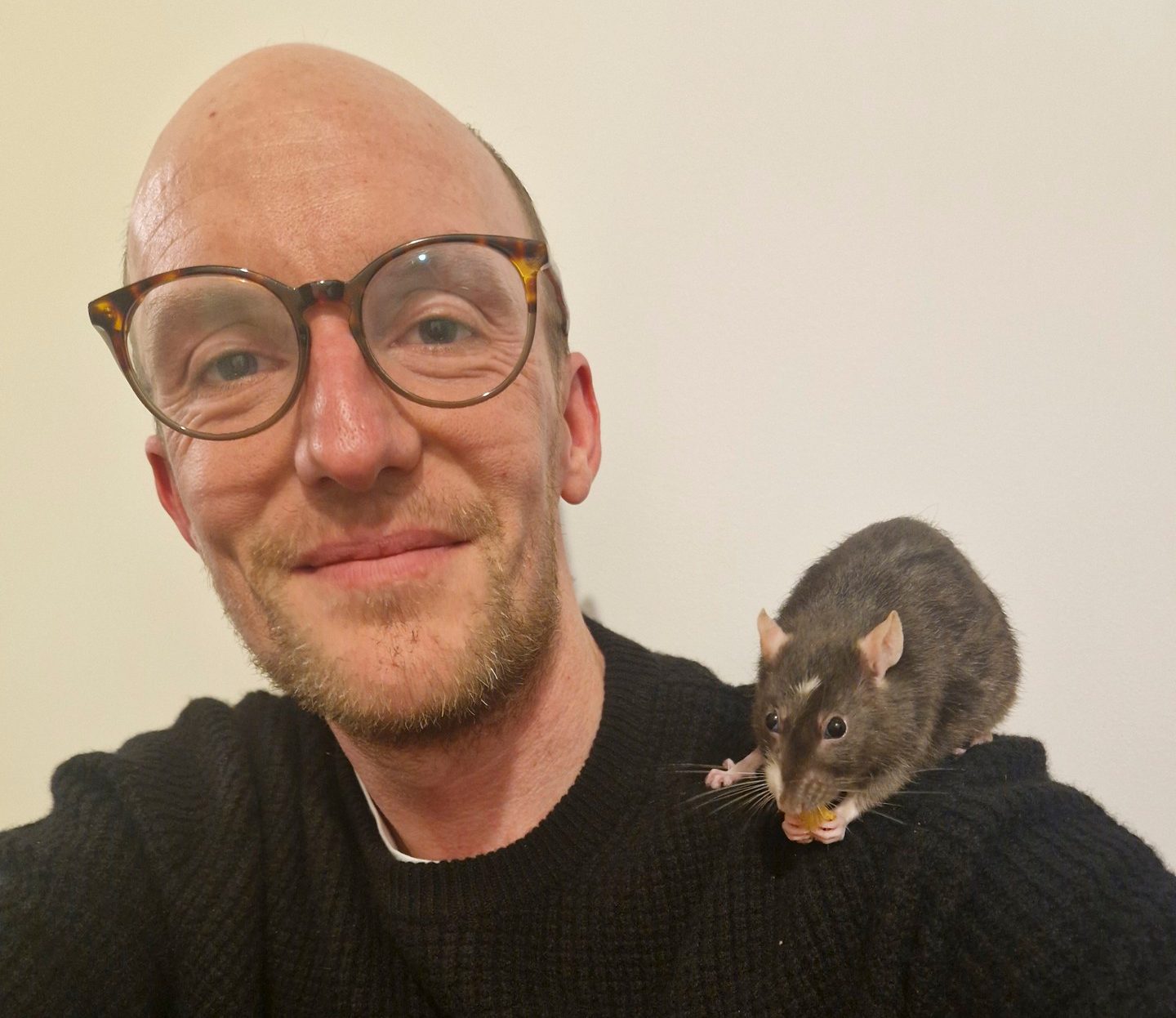
Our writer Joe Shute pictured with one of his pet fancy rats
I was once terrified of rats, but my own pets opened up to me their tenderness and playfulness and the strong emotional bonds they form. When tickled, rats even emit ultrasonic giggles inaudible to the human ear. Studies have shown rats are capable of empathy, altruism, regret, and possess impressive powers of memory, as well as the ability to judge the passage of time.
One recent study by researchers at the University of Tokyo showed that rats like to dance, making them the only species alongside humans to display an innate enjoyment of music and instinctively move to its beat. During the experiment, in which rats were played one-minute excerpts of Lady Gaga, Queen and Mozart’s Sonata for Two Pianos in D major at different speeds, it was found they kept the best time at 132 beats per minute – exactly the same as us.
Rats also grieve and have been known to bury their dead. When Molly died, Ermintrude pulled a scrap of cloth partially over her sister’s lifeless form and lay next to her until we retrieved the body.
Gradually, humanity is starting to overcome its entrenched aversion and reconsider the rat. At the Apopo project in Tanzania, rats are trained to detect landmines (due to their extraordinary powers of smell) and deployed to conflict zones around the world.
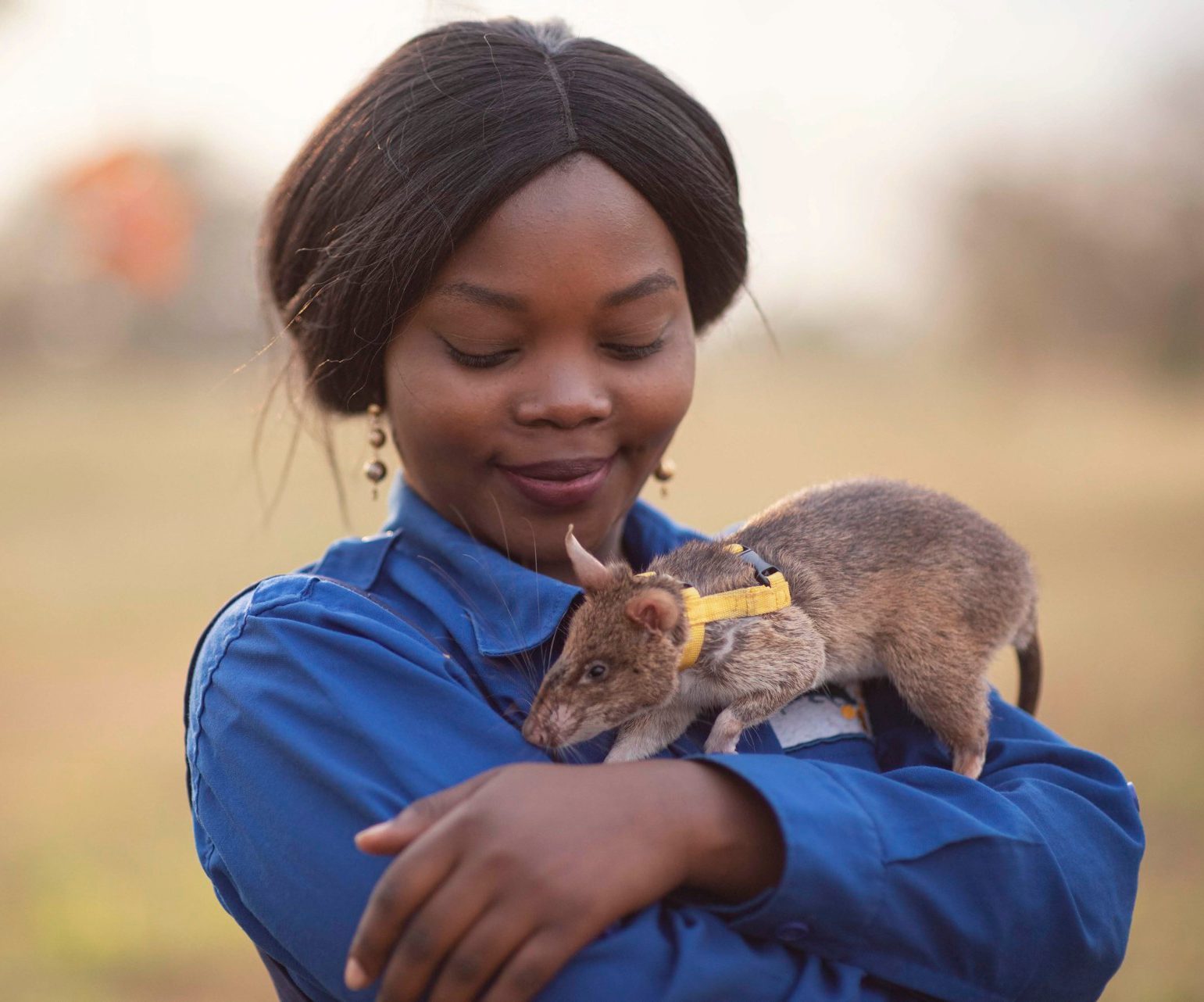
Shamsa the rat hard at work training to detect landmines (with some help from human handler Bahati) – Maria Anna Caneva Saccardo Caterina
To date the rats have cleared more than 160,000 landmines and other explosives in countries including Cambodia, Angola and Mozambique. Similarly, the rats are also used to screen tuberculosis samples, sniffing out compounds produced by the bacteria that cause the disease at a speed and precision far greater than human detection.
Apopo has also started training up rats which are able to locate survivors in the wreckage of buildings. The rats wear a backpack containing a camera, a two-way radio and a geo-locating device. When they reach their intended human target, they pull at a switch around their necks to alert their trainers.
Despite the ability of the rodents, the researchers conducting the training are still concerned about how a human, even in their most desperate moment, might react to being rescued by a rat.
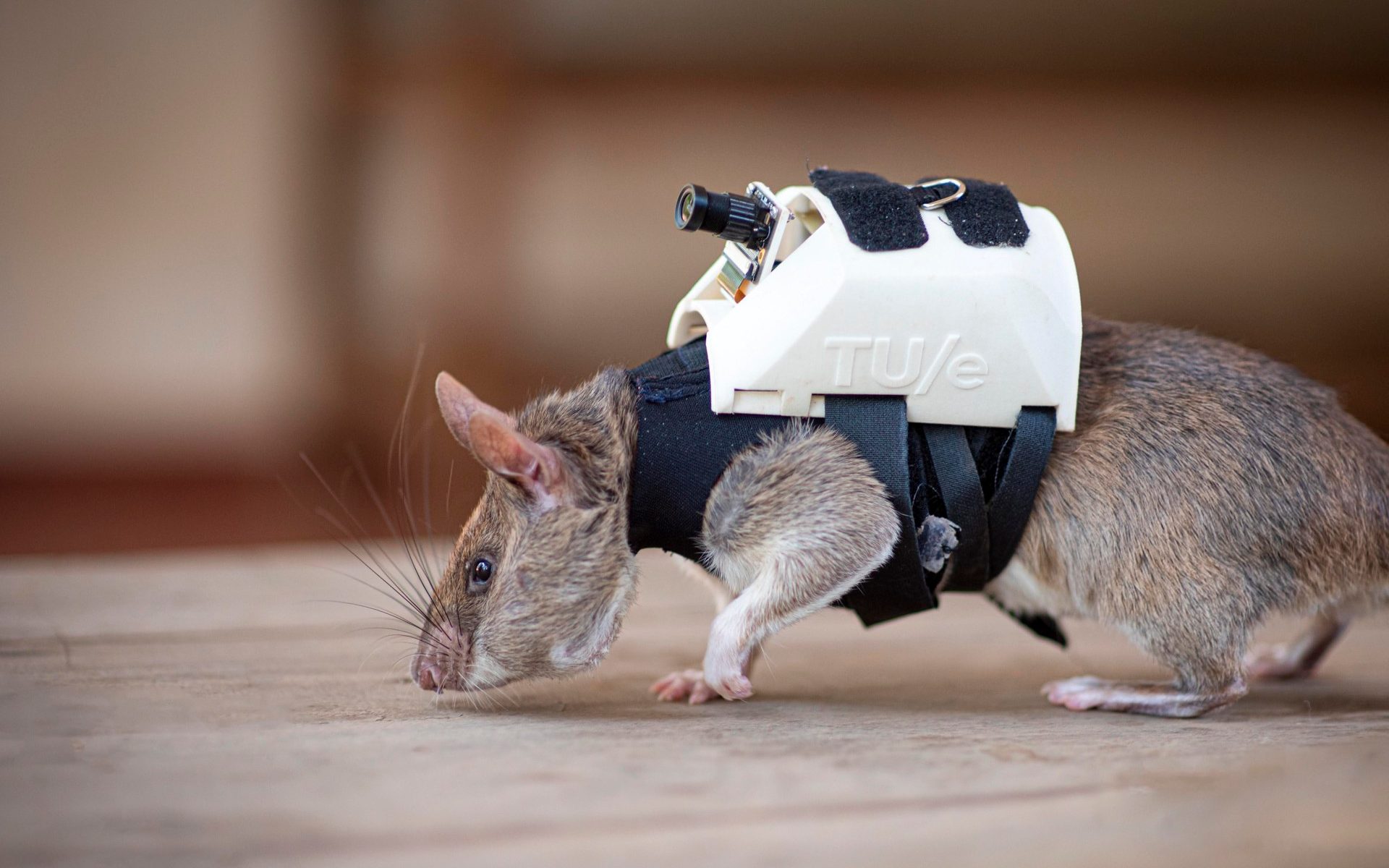
Apopo’s rats are equipped with a camera and radio to help look for survivors in building wreckage – Maria Anna Caneva Saccardo Caterina
In a recent article, Canadian public health researcher Chelsea Himsworth argued that rat-related issues should be treated as a result of policy failure. Rather than wasting time attempting to eradicate rats, city leaders should focus attention on better waste collection, tougher rules on littering, greater community cohesion and reducing antisocial behaviour. ‘This does not mean that we should love rats, nor does it mean that we need to leave them alone,’ she writes. ‘Rather, it shifts the focus to managing the ecosystem of which rats are a part, rather than focusing on the rats themselves.’
The idea of adopting this more benign approach is beginning to gain currency. One intriguing recent anthropological study conducted in Amsterdam considered the rights of rats to belong in a city. Launched in response to a spate of rat sightings in and around the Dutch capital, and based upon a wide range of interviews focused on people’s daily interactions with rats, the researchers proposed Amsterdam’s rodents be considered ‘denizens’ of the city rather than invaders. Another group of scientists in the Dutch capital are backing a ‘rat city’ project with the creation of special feeding areas for the rodents in parks, allowing people to get to know the animal.
Increasing concern over the impact of secondary poisoning on wider ecosystems is also forcing authorities into action. In 2022, the Canadian province of British Columbia introduced a permanent ban on the sale and use of second-generation anticoagulants, with only a few ‘essential’ sectors such as healthcare and food production permitted to still utilise them. In the Netherlands, the government has removed anticoagulant rodenticide for public use, with other countries expected to follow. By the end of 2024 in the UK, it will be illegal to use two second-generation anticoagulant rodenticides – bromadiolone and difenacoum – unless associated with a building, effectively rendering all second-generation anticoagulants illegal for open use.
Many studies have demonstrated the extent to which rodenticides are assimilated into the wider food chain, impacting species from barn owls to hedgehogs. Campaigners hope the stricter guidelines can finally restrict the extent of poisons leaching into the environment and further affecting wildlife.

Ezekiel, a (human) researcher who works in an Apopo lab, with (rat) assistant Julius – Picasa
But that does not mean rats are entirely in the clear. Rentokil has an experimental facility in Sussex ominously dedicated to ‘innovation’, where the firm trials the latest scientific methods in rat catching. In January 2023, it announced it had been developing new facial-recognition surveillance technology in partnership with Vodafone to track infestations and feed back real-time analysis to a central command centre, which can decide how best to dispose of the rat.
There is also work taking place to assess the potential of genetic engineering to render rats infertile (a technique already employed on mosquitos). In 2017, researchers at Edinburgh’s Roslin Institute announced they were investigating the feasibility of releasing genetically modified male rats with an ‘x-shredder’ code inserted into their DNA, meaning they could only ever pass on the y chromosome and never have female pups.
In November 2022, researchers at Adelaide University progressed this concept by announcing the results of a study into causing infertility in female laboratory mice. Using computer modelling, the researchers found that introducing 250 mice, whose genetics had been modified with something called t-CRISPR, which alters a female’s fertility gene, into an island population of 200,000 rodents could wipe them out within 20 years.
Such technology remains theoretical, but it could in time equip humanity with the ability to finally fully eradicate rats. It also poses a minefield of ethical questions. Rats may prove destructive in the environment but they are also a vital food source for other animals. If we remove them from the food chain, who knows what the knock-on effects would be?
There is also the question of where this all leads. After the successful deployment of the technology against mosquitos, and if the rat is ultimately expunged, would other unpopular species, such as the urban fox or carrion crow, follow? And above all, in the midst of an extinction and biodiversity crisis caused by human activity, what right do we have to deem which animal is permitted to share the earth with us, and which is not?
Abridged extract from Stowaway: The Disreputable Exploits of the Rat, by Joe Shute, which is out on 12 April (Bloomsbury, £18.99); pre-order at books.telegraph.co.uk
Play The Telegraph’s brilliant range of Puzzles – and feel brighter every day. Train your brain and boost your mood with PlusWord, the Mini Crossword, the fearsome Killer Sudoku and even the classic Cryptic Crossword.
News Related-
Up to 40 Tory MPs ‘set to rebel’ if Sunak’s Rwanda plan doesn’t override ECHR
-
Country diary: A tale of three churches
-
Sunak woos business elite with royal welcome – but they seek certainty
-
Neil Robertson shocked by bad results but has a plan to turn things round
-
Tottenham interested in move to sign “fearless” £20m defender in January
-
Bill payers to stump up cost of £100m water usage campaign
-
Soccer-Venue renamed 'Christine Sinclair Place' for Canada soccer great's final game
-
Phil Taylor makes his pick for 2024 World Darts Championship winner
-
Soccer-Howe aims to boost Newcastle's momentum in PSG clash
-
Hamilton heads for hibernation with a word of warning
-
Carolina Panthers fire head coach Frank Reich after 1-10 start to the season
-
This exercise is critical for golfers. 4 tips to doing it right
-
One in three households with children 'will struggle to afford Christmas'
-
Biden apologised to Palestinian-Americans for questioning Gaza death toll, says report
